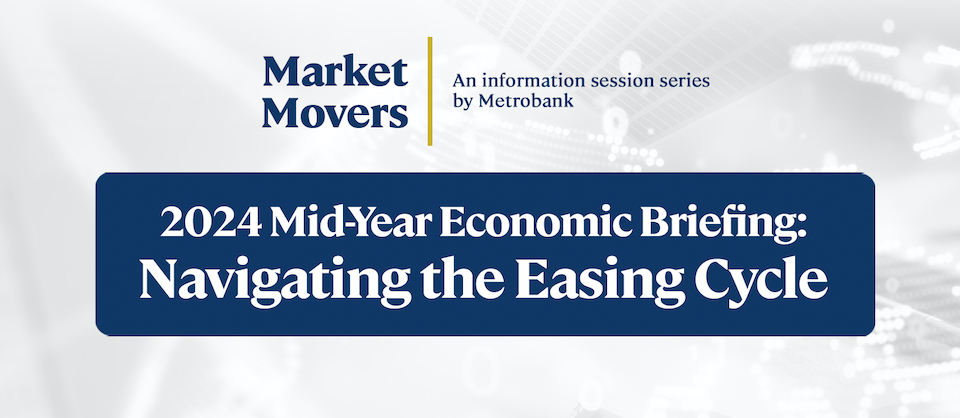Sub-sector: Technology
Read this content. Log in or sign up.
If you are an investor with us, log in first to your Metrobank Wealth Manager account.
If you are not yet a client, we can help you by clicking the SIGN UP button.

Fundamental View
AS OF 11 Jun 2025We maintain our Market perform on JD post its decent 1Q25 results; topline growth accelerated, EBITDA margin expanded and gross debt metrics improved, but free operating cash flow turned more negative on increased working capital investments which led to a contraction in net cash. We expect JD’s debt metrics to marginally improve over the next 12 months, with topline growth supported by the domestic stimulus policies, lower EBITDA margin on wider losses for its food delivery expansion, healthy FOCF which should cover its shareholder rewards, flat net cash to YE24, and steady gross leverage. We think its $ bonds trades fair compared to its Asia A/A- corporate and China tech peers, and has likely priced in its stable credit outlook and potential rating upgrade by S&P.
Business Description
AS OF 11 Jun 2025- JD is one of China's leading e-commerce and retail infrastructure service providers.
- JD has a large fulfillment infrastructure which includes over 1,600 warehouses operated by the company, and 2,000 cloud warehouses operated by third-party warehouse owner-operators under JD Logistics Open Warehouse Platform. Its warehouse network had an aggregate gross floor area of approximately over 32 mn square meters, as of 31 December 2024.
- JD has 3 operating segments, namely (1) JD Retail (83% of 1Q25 revenues), which includes JD Health and JD Industrials, and the segment mainly engages in online retail, online marketplace and marketing services in China; (2) JD Logistics (15%) which includes both internal and external logistic businesses; and (3) New businesses (2%) which consist of Dada, JD Property, Jingxi and overseas businesses.
- JD had a market capitalization of RMB 353.0 bn as of 10 June 2025.
Risk & Catalysts
AS OF 11 Jun 2025While Chinese regulators have adopted a friendlier stance towards tech companies, any regulatory clampdowns may still adversely affect the business of JD (e.g. antitrust rules, data security & personal data protection laws).
Intensifying competition amongst Chinese eCommerce platforms with the entrance of new live-streaming/short-form video platforms and group buying discount platforms may result in slower topline growth and weaker EBITDA margin for JD as its increase its user/merchant incentives and promotional activities to defend its market share.
There are regulatory risks involving the use of variable interest entities (VIEs) to circumvent China’s restrictions on foreign ownership of Internet Content Providers (ICPs). Specifically, VIE transactions involving “change in control” will be subject to antitrust regulatory processes.
Key Metric
AS OF 11 Jun 2025| RMB mn | FY21 | FY22 | FY23 | FY24 | LTM 1Q25 |
|---|---|---|---|---|---|
| Debt to Book Cap | 12.2% | 19.2% | 18.8% | 22.3% | 22.1% |
| Debt/Total Equity | 13.8% | 23.7% | 23.1% | 28.7% | 28.3% |
| Debt/Total Assets | 6.9% | 10.9% | 10.9% | 12.9% | 12.9% |
| Gross Leverage | 1.8x | 1.9x | 1.5x | 1.7x | 1.6x |
| Interest Coverage | 16.1x | 16.3x | 15.5x | 18.5x | 19.5x |
| EBITDA Margin | 2.0% | 3.3% | 4.1% | 4.6% | 4.7% |
CreditSight View Comment
AS OF 14 May 2025We maintain our Market perform on JD post its decent 1Q25 results; topline growth accelerated, EBITDA margin expanded and gross debt metrics improved, but free operating cash flow turned more negative on increased working capital investments which led to a contraction in net cash. We expect JD’s debt metrics to marginally improve over the next 12 months, with topline growth supported by the domestic stimulus policies, lower EBITDA margin on wider losses for its food delivery expansion, healthy FOCF which should cover its shareholder rewards, flat net cash to YE24, and steady gross leverage. We think its $ bonds trades fair compared to its Asia A/A- corporate and China tech peers, and has likely priced in its stable credit outlook and potential rating upgrade by S&P.
Recommendation Reviewed: May 14, 2025
Recommendation Changed: November 21, 2022
Who We Recommend
Sultanate of Oman

Korea Electric Power Corp.

Korea Gas Corp.



How may we help you?
Search topics about wealth insights and investments.Read this content. Log in or sign up.
If you are an investor with us, log in first to your Metrobank Wealth Manager account.
If you are not yet a client, we can help you by clicking the SIGN UP button.

Fundamental View
AS OF 10 Jun 2025We maintain our Outperform recommendation on Tencent post its decent 1Q25 results; topline accelerated, EBITDA margin expanded, free operating cash flow remained robust, and debt metrics remained modest. We expect Tencent’s topline growth to marginally accelerate in FY25, supported by its advertising, domestic/international gaming, fintech and cloud segments; we expect EBITDA margin to marginally improve as its better revenue mix offset the increased R&D spending for AI development; we expect FOCF to expand, and debt metrics to improve from 1Q25. We continue viewing Tencent as a core holding in China and Asia IG credits. We prefer its 2029/2041 notes for spread pick up against Chinese SOEs. We think Tencent is more attractive compared to BIDU/JD and more defensive that BBB China tech.
Business Description
AS OF 10 Jun 2025- Founded in November 1998, Tencent is a leading provider of Internet value added services in China. Since its establishment, Tencent has ventured into instant messaging, social networking, online payments, digital entertainment, and PC and smartphone gaming. Most recently, it has also forayed into high-tech areas such as artificial intelligence, and cloud computing.
- Tencent's leading Internet platforms in China include Weixin/WeChat (online messaging), QQ Instant Messenger (online messaging), Tencent Games (gaming), Tencent Video/Weixin Video Accounts (video platforms), WeChat Pay (payments), and Tencent Cloud. The combined monthly average users (MAU) of Weixin and Wechat reached 1.40 bn as of 31 March 2025.
- In 4Q24, 46% of revenues came from Value Added Services (which consist of Domestic Games, International Games, and Social Networks), 33% came from FinTech and Business Services (e.g. commercial payments and cloud), 19% from Online Advertising and 2% from Others.
- Tencent is currently primarily listed on the Hong Kong Stock Exchange, with a market capitalization of HKD 4.7 tn as of 10 June 2025.
Risk & Catalysts
AS OF 10 Jun 2025While Chinese regulators have adopted a more friendly stance towards tech companies, any regulatory clampdowns abroad and domestically (e.g. antitrust rules, data security, personal information protection laws) may affect Tencent’s business. Tencent’s gaming, music streaming, and online payment units are among those that have come under regulatory scrutiny in the past.
Tencent uses variable interest entities (VIEs) to circumvent China’s restrictions on foreign ownership of Internet Content Providers, which poses regulatory risks. Specifically, VIE transactions involving “change in control” will be subject to antitrust regulatory processes.
US-China tension may escalate under the new Trump Administration, including additional chip sanctions, which may result in higher volatility. Failing to secure a stable supply of advanced AI chips and/(or) find domestic alternatives could weigh on the long-term AI development of Tencent against international peers.
Key Metric
AS OF 10 Jun 2025| RMB bn | FY21 | FY22 | FY23 | FY24 | LTM 1Q25 |
|---|---|---|---|---|---|
| Debt to Book Cap | 27.0% | 31.4% | 29.8% | 25.4% | 26.5% |
| Net Debt to Book Cap | 6.0% | 8.5% | 1.0% | 2.3% | 4.4% |
| Debt/Total Equity | 36.9% | 45.9% | 42.5% | 34.0% | 36.0% |
| Debt/Total Assets | 20.1% | 22.8% | 23.5% | 20.1% | 21.1% |
| Gross Leverage | 1.7x | 1.9x | 1.6x | 1.3x | 1.4x |
| Net Leverage | 0.4x | 0.5x | 0.1x | 0.1x | 0.2x |
| Interest Coverage | 24.7x | 19.0x | 19.9x | 22.5x | 23.0x |
| EBITDA Margin | 34.9% | 34.3% | 38.9% | 42.4% | 43.2% |
CreditSight View Comment
AS OF 15 May 2025We maintain our Outperform recommendation on Tencent post its decent 1Q25 results; topline accelerated, EBITDA margin expanded, free operating cash flow remained robust, and debt metrics remained modest. We expect Tencent’s topline growth to marginally accelerate in FY25, supported by its advertising, domestic/international gaming, fintech and cloud segments; we expect EBITDA margin to marginally improve as its better revenue mix offset the increased R&D spending for AI development; we expect FOCF to expand, and debt metrics to improve from 1Q25. We continue viewing Tencent as a core holding in China and Asia IG credits. We prefer its 2030/2031/2041 notes for spread pick up against Chinese SOEs. We think Tencent is more attractive compared to BIDU/JD and more defensive that BBB China tech.
Recommendation Reviewed: May 15, 2025
Recommendation Changed: August 18, 2022
Who We Recommend
Sultanate of Oman

Korea Electric Power Corp.

Korea Gas Corp.



How may we help you?
Search topics about wealth insights and investments.Read this content. Log in or sign up.
If you are an investor with us, log in first to your Metrobank Wealth Manager account.
If you are not yet a client, we can help you by clicking the SIGN UP button.

Fundamental View
AS OF 10 Jun 2025We maintain our M/P on Baidu post its uninspiring 1Q25 results; topline growth was ahead of expectation on strong AI cloud demand, but EBITDA margin fell on a weaker revenue mix, FOCF turned negative on higher AI investments, debt metrics weakened, and net cash contracted. We expect a modest deterioration in Baidu’s debt metrics compared to YE24. We continue preferring Alibaba and Tencent over Baidu among A-rated China tech credits. We like the stronger balance sheet, larger scale, stronger business positions, and better credit outlook of Alibaba and Tencent. Baidu trades only 3-8 bp wider than Alibaba and Tencent which we view as rich given the limited improvement in its debt metrics over the next 12 months. For investors looking for exposure in Baidu, we prefer its Apr-2030.
Business Description
AS OF 10 Jun 2025- Founded in 2000, Baidu started out as a search engine business and began its development into artificial intelligent (AI) since 2010.
- Baidu Core is the main revenue driver of the company (78% of 1q25 revenues) which provides search-based, feed-based and other online marketing services (total: 53% of 3Q24 revenues), as well as products and services from new AI initiatives (29% of revenues); Baidu's AI initiatives include AI cloud (enterprise & public sector cloud, and personal cloud), Intelligent Group Driving (Apollo Go, Apollo auto solutions, and intelligent EVs under Jidu Auto), Mobile Ecosystem (Baidu App, ERNIE Bot, Haokan and Baidu Post), and other growth initiatives (ie. Xiaodu smart devices powered by DuerOS smart assistant and AI chips).
- iQiyi accounts for the remaining revenues of Baidu; iQIYI is an online video platform with a content library that includes licensed movies, television series, cartoons, and other programs.
- Baidu launched ERNIE bot in Mar-23, a generative AI chatbot powered by ERNIE, Baidu's in-house foundation model.
- Baidu has a market capitalization of RMB 223.4 bn as of 10 June 2025.
Risk & Catalysts
AS OF 10 Jun 2025Any regulatory clampdowns abroad and domestically (e.g. potential US investment ban, antitrust rules, data security and personal information protection laws) may adversely affect the business of Baidu. The interpretation of Chinese laws and regulations involves some degree of uncertainty.
There are regulatory risks given the corporate structure which uses variable interest entities (VIEs) to circumvent China’s restrictions on foreign ownership of Internet Content Providers (ICPs).
Baidu has made significant investments into long-term AI-related projects, which may take time to turn profitable. A potential escalation of the US chip restriction could have a material negative impact its AI related business (ie. cloud, ernie bot, autonomous driving).
Key Metric
AS OF 10 Jun 2025| RMB bn | FY21 | FY22 | FY23 | FY24 | LTM 1Q25 |
|---|---|---|---|---|---|
| Debt to Book Cap | 29.7% | 28.5% | 25.0% | 22.5% | 26.7% |
| Debt/Total Equity | 42.2% | 39.8% | 33.4% | 29.0% | 36.4% |
| Debt/Total Assets | 24.1% | 23.4% | 20.8% | 18.5% | 22.5% |
| Gross Leverage | 3.3x | 2.8x | 2.2x | 2.0x | 2.6x |
| Interest Coverage | 8.2x | 11.4x | 12.1x | 13.8x | 13.5x |
| EBITDA Margin | 22.6% | 26.8% | 29.2% | 29.3% | 28.9% |
CreditSight View Comment
AS OF 22 May 2025We maintain our M/P on Baidu post its uninspiring 1Q25 results; topline growth was ahead of expectation on strong AI cloud demand, but EBITDA margin fell on a weaker revenue mix, FOCF turned negative on higher AI investments, debt metrics weakened, and net cash contracted. We expect a modest deterioration in Baidu’s debt metrics compared to YE24. We continue preferring Alibaba and Tencent over Baidu among A-rated China tech credits. We like the stronger balance sheet, larger scale, stronger business positions, and better credit outlook of Alibaba and Tencent. Baidu trades only 3-8 bp wider than Alibaba and Tencent which we view as rich given the limited improvement in its debt metrics over the next 12 months. For investors looking for exposure in Baidu, we prefer its Apr-2030.
Recommendation Reviewed: May 22, 2025
Recommendation Changed: August 31, 2022
Who We Recommend
Sultanate of Oman

Korea Electric Power Corp.

Korea Gas Corp.



How may we help you?
Search topics about wealth insights and investments.Read this content. Log in or sign up.
If you are an investor with us, log in first to your Metrobank Wealth Manager account.
If you are not yet a client, we can help you by clicking the SIGN UP button.

Fundamental View
AS OF 10 Jun 2025We maintain our Outperform recommendation on Alibaba post its decent 1Q25 results; topline growth marginally slowed, EBITDA margin improved,FOCF fell on higher capex, net cash remained robust and debt metrics were stable. We expect Alibaba’s topline growth to accelerate over FY26, driven by better domestic eCommerce monetization, resilient international eCommerce, and robust cloud demand; we expect EBITDA margin to remain flat at 20%, but FOCF to trend lower on a material increase in capex for cloud; that said, we expect Alibaba’s Total debt/EBITDA to improve over the next 12 months, and maintain its healthy net cash position. We continue to view Alibaba as a core holding in Asia IG credits. We prefer its 30/35/41 bonds for spread pick up against Chinese SOEs.
Business Description
AS OF 10 Jun 2025- Founded in 1999, Alibaba is the largest retail commerce company in the world based on gross merchandise volume (GMV) as of 31 March 2023.
- The company's business segments comprise Taobao & Tmall Group (39% of F4Q25 revenue; China e-commerce incl. Taobao, Tmall, Taobao Deals, Taocaicai, 1688.com), International Digital Commerce (13%; incl. Lazada, AliExpress, Trendyol and Daraz), Cloud Intelligence Group (11%; incl. AliCloud, AI), logistic provider Cainiao (8%), Local Consumer Services (6%; incl. Ele.me, Amap), and Digital Media and Entertainment (2%, incl. Youku & Alibaba Pictures) and Others (21%; incl. Freshippo, Fliggy, Alibaba Health, Intelligent Information Platform, SunArt, DingTalk).
- Taobao/Tmall is Alibaba's core business and the main EBITA & cash generation unit of the group. Alibaba's annual active consumer exceeded 1 bn in June-2022.
- Alibaba had a market capitalization of RMB 2.3 tn as of 10 June 2025.
Risk & Catalysts
AS OF 10 Jun 2025While Chinese policymakers have adopted an increasingly friendly stance towards tech platforms, regulatory clampdown (e.g. anti-monopoly guidelines, data security laws, personal information protection laws) may still affect Alibaba as it increases compliance cost. There are regulatory risks given the corporate structure which uses variable interest entities (VIEs) to circumvent China’s restrictions on foreign ownership of Internet Content Providers (ICPs).
Intensifying competition amongst eCommerce platforms may result in slower topline growth and weaker EBITDA margins.
Alibaba does not control Alipay but relies on Alipay to conduct substantially all the payment processing and escrow services on its marketplaces.
US-China tension may escalate under the new Trump Administration, including additional chip sanctions, which may result in higher volatility. Failing to secure a stable supply of advanced AI chips and/(or) find domestic alternatives could weigh on the long-term AI development of Tencent against international peers.
Key Metric
AS OF 10 Jun 2025| CNY BN | FY21 | FY22 | FY23 | FY24 | FY25 |
|---|---|---|---|---|---|
| Debt to Book Cap | 12.1% | 11.6% | 12.6% | 13.3% | 17.5% |
| Debt/Total Equity | 13.8% | 13.1% | 14.4% | 15.3% | 21.2% |
| Debt/Total Assets | 8.8% | 8.3% | 9.2% | 9.7% | 12.8% |
| Gross Leverage | 0.8x | 0.9x | 0.9x | 0.9x | 1.2x |
| Interest Coverage | 39.9x | 32.2x | 29.6x | 24.0x | 20.7x |
| EBITDA Margin | 24.9% | 18.5% | 20.2% | 20.3% | 19.9% |
CreditSight View Comment
AS OF 16 May 2025We maintain our Outperform recommendation on Alibaba post its decent 1Q25 results; topline growth marginally slowed, EBITDA margin improved,FOCF fell on higher capex, net cash remained robust and debt metrics were stable. We expect Alibaba’s topline growth to accelerate over FY26, driven by better domestic eCommerce monetization, resilient international eCommerce, and robust cloud demand; we expect EBITDA margin to remain flat at 20%, but FOCF to trend lower on a material increase in capex for cloud; that said, we expect Alibaba’s Total debt/EBITDA to improve over the next 12 months, and maintain its healthy net cash position. We continue to view Alibaba as a core holding in Asia IG credits. We prefer its 30/31/35/41 bonds for spread pick up against Chinese SOEs.
Recommendation Reviewed: May 16, 2025
Recommendation Changed: August 05, 2022
Who We Recommend
Sultanate of Oman

Korea Electric Power Corp.

Korea Gas Corp.



How may we help you?
Search topics about wealth insights and investments.Read this content. Log in or sign up.
If you are an investor with us, log in first to your Metrobank Wealth Manager account.
If you are not yet a client, we can help you by clicking the SIGN UP button.

Fundamental View
AS OF 18 Mar 2025- Netflix is one of the few clear winners in the industry’s transition to streaming, and we believe the group’s leading position will be bolstered in 2025 as legacy media companies continue to rein in spending and international ambitions.
- From a financial perspective, we expect Netflix will deliver 20+% EBITDA growth in 2025 driven by a mix of subscriber growth, price hikes and margin expansion.
- Netflix’s financial policy is relatively conservative. While the company no longer targets $10-15 billion of gross debt, we view Netflix’s new financial policy as an evolution rather than a revolution and expect credit metrics to remain best in class.
Business Description
AS OF 18 Mar 2025- NFLX is the world's leading subscription streaming entertainment service with ~302 mn paid streaming subs in 190+ countries around the world. NFLX's programming includes original & acquired TV series, documentaries and feature films.
- NFLX began expanding internationally with the launch of services in Canada (Sep 2010), followed by LatAm (Sep 2011), and the UK and Ireland (Jan 2012). NFLX launched services in 17 more markets at a measured pace through the end of 2015 before launching in the rest of the world in Jan 2016 (ex-China, N Korea, Syria, Crimea).
- As of FY24, Netflix's regional subscriber breakdown was as follows: (1) EMEA - 101.1 mn; (2) UCAN - 89.6 mn; (3) APAC - 57.5 mn and (4) LATAM - 53.3 mn.
- Ted Sarandos and Greg Peters are Co-CEOs, with Mr. Sarandos appointed to the position in July 2020 and Mr. Peters in January 2023. Co-founder Reed Hastings was appointed as executive chairman of the Board in January 2023.
Risk & Catalysts
AS OF 18 Mar 2025- Market Saturation: Netflix is highly penetrated in the US market, so future growth will become increasingly dependent on price increases, uptake of the ad tier and success on the password sharing crackdown. The recent WWE and NFL deals also opens the door to higher-priced sports programming.
- Increased Competition: Several large competitors including Amazon and Apple are increasingly leaning into DTC video offerings on a global basis. Heightened competition may result in rising churn & declining gross additions for NFLX.
- M&A Risk: Netflix is in the early stages of an expansion into video games and has already acquired several studios. Additionally, several legacy media companies are weakly positioned and are actively considering asset sales. We believe Netflix has no interest in linear TV assets, but could be open to a studio purchase under the right circumstances.
Key Metric
AS OF 18 Mar 2025| $ mn | FY20 | FY21 | FY22 | FY23 | FY24 |
|---|---|---|---|---|---|
| Revenue | 24,996 | 29,698 | 31,616 | 33,723 | 39,001 |
| Revenue YoY % | 24.0% | 18.8% | 6.5% | 6.7% | 15.6% |
| EBITDA | 5,116 | 6,806 | 6,695 | 7,650 | 11,019 |
| EBITDA Growth | 64% | 33% | (2%) | 14% | 44% |
| Cash Content Expense | 12,537 | 17,469 | 16,660 | 13,140 | 17,003 |
| CFO - CapEx | 1,929 | (132) | 1,619 | 6,926 | 6,922 |
| Dividends/CFO-Capex | 0.0% | 0.0% | 0.0% | 0.0% | 0.0% |
| LTM CFO-CapEx to Debt | 11.8% | (0.9%) | 11.3% | 47.6% | 44.4% |
CreditSight View Comment
AS OF 18 Apr 2025We believe Netflix’s premium valuation is justified given the group’s leading scale, operating momentum and credit metrics, which stand in stark contrast to the pressures facing legacy media peers. Netflix is one of the few clear winners in the industry’s transition to streaming, and we believe the group is on track to extend its leading position during a period of rising macro uncertainty since its legacy media competition is much more exposed to advertising market pressures. The company’s gross leverage is already best in class at ~1.3x, and we expect Netflix can generate ~$8+ billion of FCF in FY25 with a FCF to debt ratio in the ~60% area. Netflix is also positioned to maintain its double-digit top line and profit growth in 2025.
Recommendation Reviewed: April 18, 2025
Recommendation Changed: October 20, 2022
Who We Recommend
Sultanate of Oman

Korea Electric Power Corp.

Korea Gas Corp.



How may we help you?
Search topics about wealth insights and investments.Read this content. Log in or sign up.
If you are an investor with us, log in first to your Metrobank Wealth Manager account.
If you are not yet a client, we can help you by clicking the SIGN UP button.

Fundamental View
AS OF 25 Feb 2025We are encouraged by Meta’s strong advertising growth relative to peers in 2023 and 2024. Meta has extremely strong credit metrics of 0.3x gross leverage and $49 bn net cash. We continue to expect Meta to be a regular/annual issuer to fund its shareholder returns and massive investments in AI and the metaverse.
Longer term, we expect Meta to adhere to its previously communicated financial policy of maintaining a positive or neutral cash balance. Meta does have legal and regulatory risks notably an FTC suit that seeks to unwind its prior acquisitions of Instagram and WhatsApp. However, not all event risk is negative as Meta would be the greatest beneficiary from a potential TikTok ban.
Business Description
AS OF 25 Feb 2025- Meta Platforms is the largest social networking company in the world. Meta generates substantially all of its revenue from advertising which includes Facebook, Instagram, Messenger, and third-party affiliated websites or mobile applications.
- In 4Q24, Family of Apps was 98% of revenue (96.7% from advertising and 1.1% from other) and Reality Labs was 2% of revenue. Reality Labs generated $17.7 bn in operating losses during LTM 4Q24 as the company is investing heavily in the metaverse.
- There are 3.35 bn Family Daily Active People (DAP) as of 4Q24, and the Family Average Revenue per Person (ARPP) was $14.25 quarterly in 4Q24.
- Meta is headquartered in Menlo Park, California. Employee headcount was >74k at 4Q24.
Risk & Catalysts
AS OF 25 Feb 2025In December 2020, the FTC filed a lawsuit against Meta targeting its acquisitions of Instagram and Whatsapp. If Meta is forced to unwind prior acquisitions, this would be a credit negative given reduced scale and diversification.
Meta’s business model relies almost entirely on user-generated content. As such, there are risks related to customer privacy (e.g., Cambridge Analytica data scandal in 2018) and regulatory changes (e.g., Section 230 protections).
In April 2024, the US signed into law a bill requiring a sale or ban of TikTok, although Trump signed an executive order instructing the Attorney General to not enforce the TikTok ban for 75 days (to 4/5/2025). If a ban is implemented, this would positively impact Meta and others with competing short-form video products.
In October 2022, activist Altimeter Capital wrote a letter to Zuck and Board although it was on the friendly-side of activism and some suggestions have already been implemented.
Key Metric
AS OF 25 Feb 2025| $ mn | 2020 | 2021 | 2022 | 2023 | LTM 4Q24 |
|---|---|---|---|---|---|
| Revenue YoY % | 21.6% | 37.2% | (1.1%) | 15.7% | 21.9% |
| EBITDA | 46,069 | 63,882 | 49,622 | 71,955 | 101,568 |
| EBITDA Margin | 53.6% | 54.2% | 42.6% | 53.3% | 61.7% |
| CapEx % of Sales | 18.3% | 16.3% | 27.5% | 20.8% | 23.8% |
| Sh. Ret. % of CFO-CapEx | 27% | 116% | 152% | 46% | 68% |
| Net Debt | (61,954) | (47,998) | (30,815) | (47,018) | (48,989) |
| Gross Leverage | 0.0x | 0.0x | 0.2x | 0.3x | 0.3x |
| EV / EBITDA | 15.8x | 14.0x | 5.8x | 12.3x | 14.5x |
CreditSight View Comment
AS OF 01 May 2025We are encouraged by Meta’s strong advertising growth relative to peers in 2023, 2024, and 1Q25. Meta has extremely strong credit metrics of 0.3x gross leverage and $41 bn net cash. We continue to expect Meta to be a regular/annual issuer to fund its shareholder returns and massive investments in AI and the metaverse. Longer term, we expect Meta to adhere to its previously communicated financial policy of maintaining a positive or neutral cash balance. Meta does have legal and regulatory risks notably an FTC suit that seeks to unwind its prior acquisitions of Instagram and WhatsApp. In addition, the recent EC decision could have an impact as early as 3Q25. However, not all event risk is negative as Meta would be the greatest beneficiary from a potential TikTok ban.
Recommendation Reviewed: May 01, 2025
Recommendation Changed: April 18, 2024
Who We Recommend
Sultanate of Oman

Korea Electric Power Corp.

Korea Gas Corp.



How may we help you?
Search topics about wealth insights and investments.Read this content. Log in or sign up.
If you are an investor with us, log in first to your Metrobank Wealth Manager account.
If you are not yet a client, we can help you by clicking the SIGN UP button.

Fundamental View
AS OF 25 Feb 2025- We continue to have confidence in CEO Andy Jassy and the company’s long-term business for both AWS and Stores. The recent operating trends reinforce our views particularly the margin improvement. We continue to believe that Amazon is an underappreciated winner in Generative AI given the breadth of its cloud business and offerings including custom silicon and its platform Bedrock.
- Gross leverage declined to 0.4x and 0.9x on a lease-adjusted basis. While Amazon is increasing its capex spend (along with the other hyperscalers), we are encouraged by its debt reduction and zero shareholder returns. Also, Amazon’s equity cushion is ~$2.2 tn. There are risks related to the FTC suit although we expect those to be addressed by behavioral remedies, and we view a breakup as unlikely.
Business Description
AS OF 25 Feb 2025- Amazon is an e-commerce company which sells a wide range of its own products and those of 3rd party sellers. Amazon offers fulfillment services for 3rd party sellers (FBA) and sells cloud computing services (AWS). In 4Q24, 3rd party units were 62% of total paid units, and FBA units are a majority of 3rd party units.
- In LTM 4Q24, NA segment was 61% of sales, International was 22% of sales, and AWS was 17% of sales.
- Amazon disclosed it surpassed 200 mn Prime members in April 2021. The annual membership was increased in February 2022 from $119 to $139 in the US, although fees vary by country. In mid-2019, Amazon Prime began to transition from 2-day to 1-day shipping. Amazon Prime also offers Prime Video, streaming music, and other benefits.
- In 2006, Amazon launched AWS which remains the leader in cloud computing (IaaS/PaaS). Amazon sells its own devices (e-reader, smart speaker, streaming media player, etc.).
Risk & Catalysts
AS OF 25 Feb 2025- We think Amazon has moderate event risk given its large size (~$2.2 tn market cap).
- While Amazon is increasing its CapEx spend, we are encouraged by the $14 bn reduction in lease-adjusted debt from year-end 2022 through year-end 2024.
- Amazon continues to face regulatory scrutiny. In September 2023, the FTC and 17 states filed a lawsuit against Amazon and accused the company of (1) punishing sellers for offering lower prices elsewhere and (2) making Prime eligibility conditional on usage of fulfillment services. The biggest risk would be a breakup, although we view that as unlikely.
- Amazon’s $14 bn acquisition of Whole Foods has shown its proclivity for large M&A, although the regulatory environment could make large deals challenging.
Key Metric
AS OF 25 Feb 2025| $ mn | 2020 | 2021 | 2022 | 2023 | LTM 4Q24 |
|---|---|---|---|---|---|
| Revenue YoY % | 37.6% | 21.7% | 9.4% | 11.8% | 11.0% |
| EBITDA | 57,284 | 71,994 | 74,593 | 110,305 | 144,162 |
| EBITDA Margin | 14.8% | 15.3% | 14.5% | 19.2% | 22.6% |
| CapEx % of Sales | 12.1% | 13.3% | 11.5% | 8.5% | 12.3% |
| Sh. Ret. % of CFO-CapEx | 0% | 0% | (49%) | 0% | 0% |
| Net Debt | (50,497) | (44,771) | 7,316 | (19,598) | (43,202) |
| Gross Leverage | 0.6x | 0.7x | 1.0x | 0.6x | 0.4x |
| EV / EBITDA | 28.3x | 23.3x | 11.7x | 14.4x | 16.1x |
CreditSight View Comment
AS OF 11 Jun 2025We continue to have confidence in CEO Andy Jassy and the company’s long-term business for both AWS and Stores. AWS is now a $117 bn run-rate business and delivered record operating margin of 39.5% in 1Q25. We continue to believe that Amazon will be a winner in Generative AI given the breadth of its cloud business and offerings including custom silicon (Trainium, Inferentia) and its platform Amazon Bedrock. We estimate leverage was roughly flat at 0.4x gross and 0.9x lease-adjusted gross. While Amazon’s capex has been ramping, along with other hyperscalers, we are encouraged by its debt reduction over the past few years and zero shareholder returns. Also, Amazon’s market cap is $2.1 tn. There are risks related to the FTC suit although we view a breakup as unlikely.
Recommendation Reviewed: June 11, 2025
Recommendation Changed: May 01, 2024
Who We Recommend
Sultanate of Oman

Korea Electric Power Corp.

Korea Gas Corp.










 DOWNLOAD
DOWNLOAD



